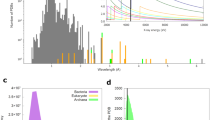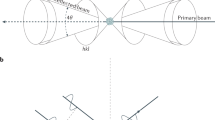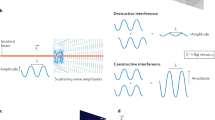Abstract
Multiwavelength anomalous diffraction (MAD) phasing, which relies on synchrotron radiation, has grown from a novelty technique to a mainstream method that has been used to determine macromolecule structures of up to 200,000 Mr.
This is a preview of subscription content, access via your institution
Access options
Subscribe to this journal
Receive 12 print issues and online access
$189.00 per year
only $15.75 per issue
Buy this article
- Purchase on Springer Link
- Instant access to full article PDF
Prices may be subject to local taxes which are calculated during checkout


Similar content being viewed by others
References
Hope, H. Crystallography of biological macromolecules at ultra-low temperature. Ann. Rev. Biophys. Biophys. Chem. 19, 107–126 (1990).
Staudenmann, J.–L., Hendrickson, W.A., & Abramowitz, R. Synchrotron Resource of the Howard Hughes Medical Institute. Rev. Sci. Instrum. 60, 1939– 1942 (1989).
Shapiro, L. et al. Structural basis of cell-cell adhesion by cadherins. Nature 374, 327–337 (1995).
Lima, C.D. et al. MAD analysis of FHIT, a putative human tumor suppressor from the HIT protein family. Structure 5, 763–774 (1997).
Hendrickson, W.A. Determination of macromolecular structures from anomalous diffraction of synchrotron radiation. Science 254, 51– 58 (1991).
Ramakrishnan, V. and Biou, V. Treatment of multiwavelength anomalous diffraction data as a special case of multiple isomorphous replacement. Meth. Enz. 276 (Part A) 538– 557 (1997).
Brunger, A.T. et al. Crystallography and NMR System: A new software suite for macromolecular structure determination, Acta Crystallogr D in the press (1998).
La Fortelle, E. de & Bricogne, G. Maximum – likelihood heavy atom parameter refinement for multiple isomorphous replacement and multiwavelength anomalous diffraction methods. Meth. Enz. 276 (Part B) 472–494 (1997).
Hendrickson, W.A., Horton, J.R. & LeMaster, D.M. Selenomethionyl proteins produced for anlysis by multiwavelength anomalous diffraction (MAD): a vehicle for direct determination of three-dimensional structure. EMBO J. 9, 1665– 1672 (1990).
Doublie, S. Preparation of selenomethionyl proteins for phase determination. Meth. Enz. 276 (Part A) 523–537 (1997).
Turner, M.A. et al. Structure determination of selenomethionyl S-adenosylhomocysteine hydrolase using data at a single wavelength. Nature Struct. Biol. 5, 369–376 (1998).
Escalante, C.R., Yie, J., Thanos, D. & Aggarwal, A.K. Structure of IRF – 1 with bound DNA reveals determinants of interferon regulation. Nature 391, 103–106 (1998).
Correll, C.C., Freeborn, B., Moore, P.B. & Steitz, T.A. Metals, Motifs and recognition in the crystal structure of a 5S rRNA Domain. Cell 91, 705–712 (1997).
Correll, C.C., Freeborn, B., Moore, P.B. and Steitz, T.A. Use of chemically modified nucleotides to determine a 62-nucleotide RNA crystal structure: A Survey of phophorothioates, Br, Pt and Hg. J. Biomolec. Struct. Dynam. 15, 165–172 (1997).
Schiltz, M. et al. Protein Crystallography at ultra-short wavelengths: feasibility study of anomalous-dispersion experiments at the xenon K-edge. J. Synchrotron Rad. 4, 287–297 (1997).
Wu, H., Lustbader, J.W., Liu, Y., Canfield, R.E. & Hendrickson, W.A. Structure of human chorionic gonadotropin at 2.6Å resolution from MAD analysis of the selenomethionyl protein. Structure 2, 545–558 (1994).
Acknowledgements
I thank W. Hendrickson for numerous contributions, Y. Liu for sharing results and Fig. 1, and the Howard Hughes Medical Institute and the staff of X4A for support and development of Beamline X4A at the NSLS.
Author information
Authors and Affiliations
Rights and permissions
About this article
Cite this article
Ogata, C. MAD phasing grows up. Nat Struct Mol Biol 5 (Suppl 8), 638–640 (1998). https://doi.org/10.1038/1330
Issue Date:
DOI: https://doi.org/10.1038/1330
This article is cited by
-
Biomicrofluidics: Recent trends and future challenges
Sadhana (2009)



